An Analysis of CSR and Human Rights in Bangladesh Textiles
VerifiedAdded on 2022/11/16
|17
|4391
|311
Report
AI Summary
This report provides a comprehensive analysis of corporate social responsibility (CSR) and human rights issues within the Bangladesh textile industry. It begins with an overview of the industry, highlighting its significance to the nation's GDP and the prevalence of a low-wage labor force, predominantly female. The report then delves into specific human rights concerns, including low worker remuneration, degraded working conditions with a lack of safety measures, the absence of worker unions, and discrimination in the workplace, particularly against women. The study examines the Mohammadi Group as a case study, suggesting actions the company can take to address these issues, such as improving wages, enhancing working conditions, encouraging unionization, and empowering female workers. The report concludes by emphasizing the need for improved CSR practices to ensure worker well-being and sustainable industry growth. The report draws on various academic sources and industry reports to support its findings and recommendations.
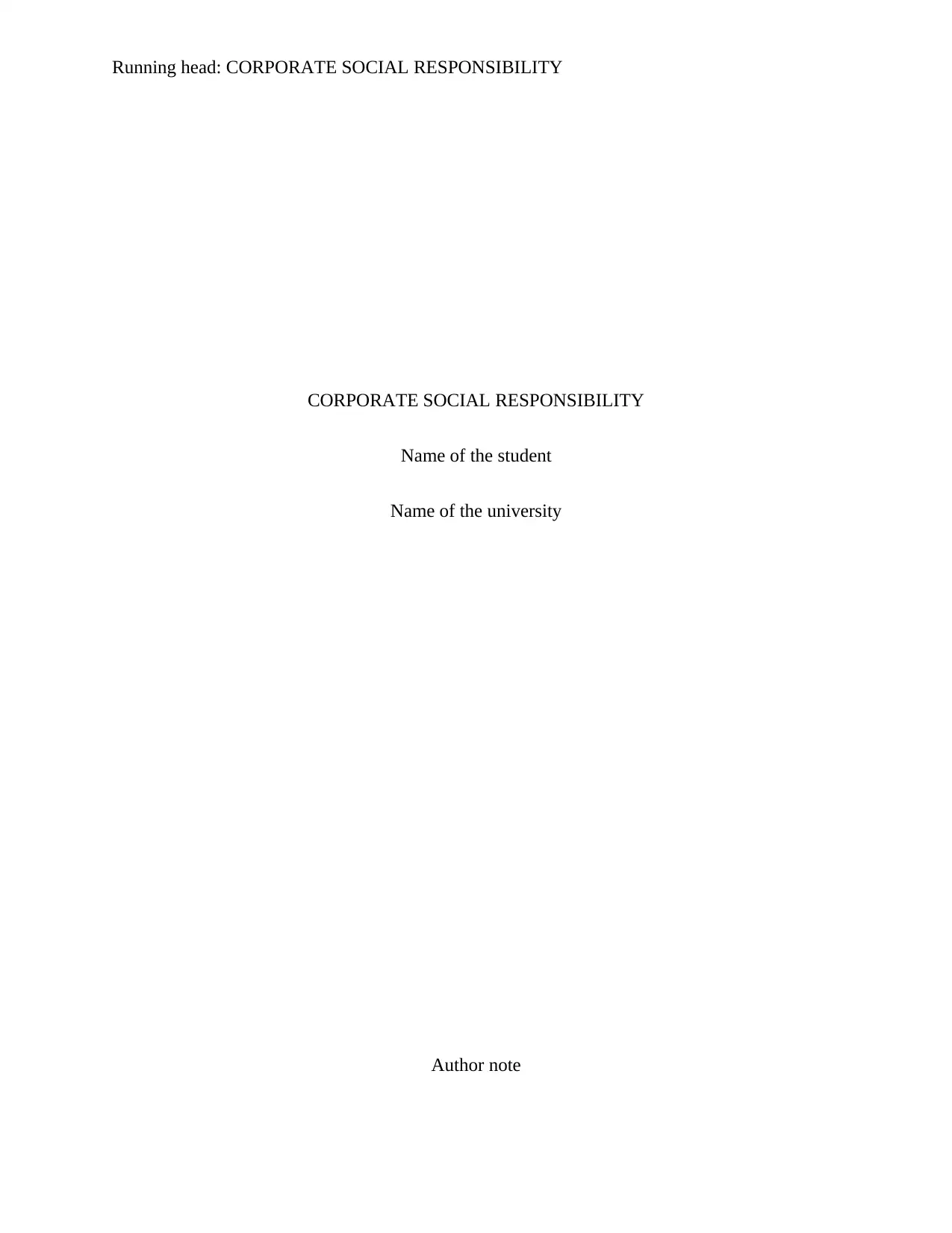
Running head: CORPORATE SOCIAL RESPONSIBILITY
CORPORATE SOCIAL RESPONSIBILITY
Name of the student
Name of the university
Author note
CORPORATE SOCIAL RESPONSIBILITY
Name of the student
Name of the university
Author note
Paraphrase This Document
Need a fresh take? Get an instant paraphrase of this document with our AI Paraphraser
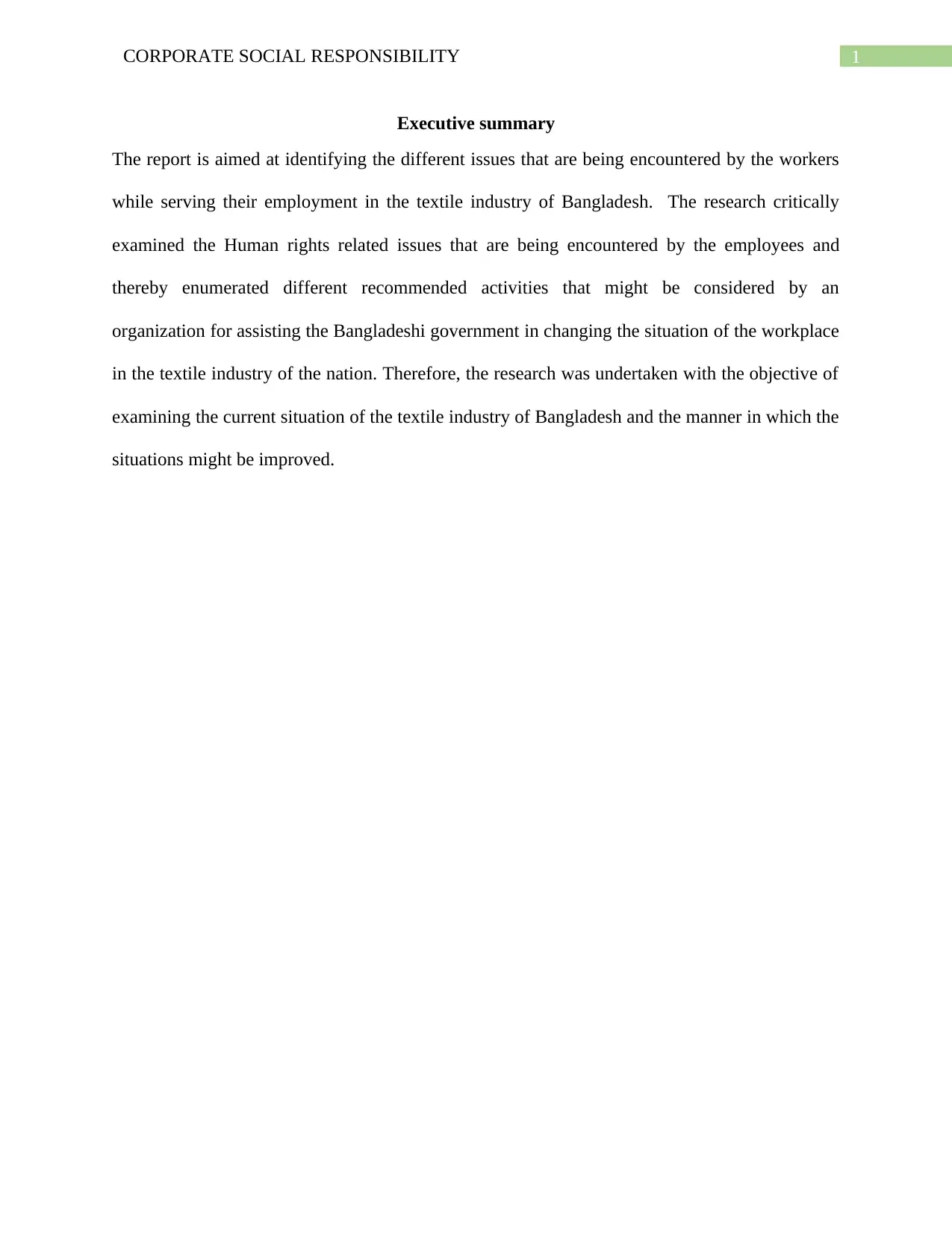
1CORPORATE SOCIAL RESPONSIBILITY
Executive summary
The report is aimed at identifying the different issues that are being encountered by the workers
while serving their employment in the textile industry of Bangladesh. The research critically
examined the Human rights related issues that are being encountered by the employees and
thereby enumerated different recommended activities that might be considered by an
organization for assisting the Bangladeshi government in changing the situation of the workplace
in the textile industry of the nation. Therefore, the research was undertaken with the objective of
examining the current situation of the textile industry of Bangladesh and the manner in which the
situations might be improved.
Executive summary
The report is aimed at identifying the different issues that are being encountered by the workers
while serving their employment in the textile industry of Bangladesh. The research critically
examined the Human rights related issues that are being encountered by the employees and
thereby enumerated different recommended activities that might be considered by an
organization for assisting the Bangladeshi government in changing the situation of the workplace
in the textile industry of the nation. Therefore, the research was undertaken with the objective of
examining the current situation of the textile industry of Bangladesh and the manner in which the
situations might be improved.
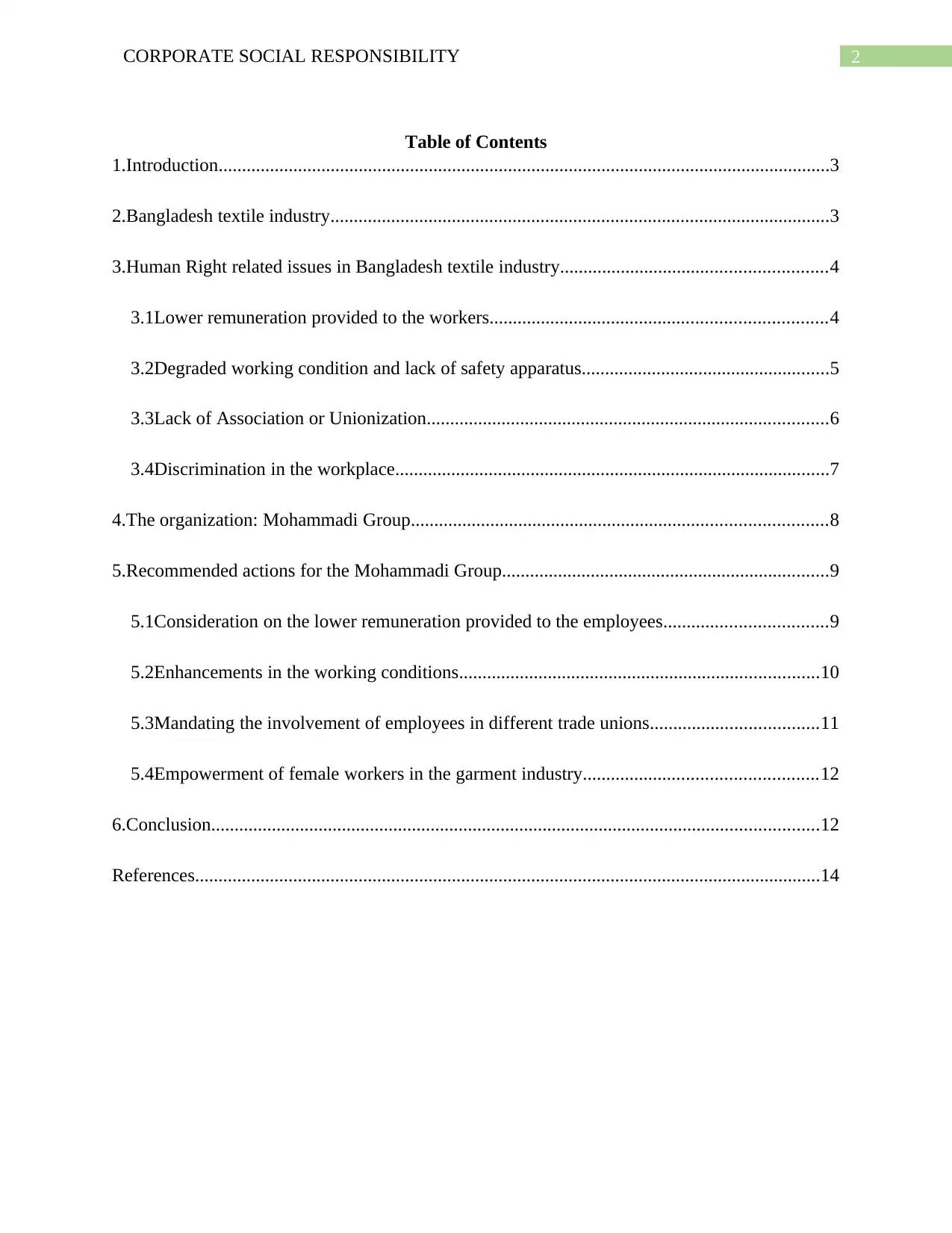
2CORPORATE SOCIAL RESPONSIBILITY
Table of Contents
1.Introduction...................................................................................................................................3
2.Bangladesh textile industry...........................................................................................................3
3.Human Right related issues in Bangladesh textile industry.........................................................4
3.1Lower remuneration provided to the workers........................................................................4
3.2Degraded working condition and lack of safety apparatus.....................................................5
3.3Lack of Association or Unionization......................................................................................6
3.4Discrimination in the workplace.............................................................................................7
4.The organization: Mohammadi Group.........................................................................................8
5.Recommended actions for the Mohammadi Group......................................................................9
5.1Consideration on the lower remuneration provided to the employees...................................9
5.2Enhancements in the working conditions.............................................................................10
5.3Mandating the involvement of employees in different trade unions....................................11
5.4Empowerment of female workers in the garment industry..................................................12
6.Conclusion..................................................................................................................................12
References......................................................................................................................................14
Table of Contents
1.Introduction...................................................................................................................................3
2.Bangladesh textile industry...........................................................................................................3
3.Human Right related issues in Bangladesh textile industry.........................................................4
3.1Lower remuneration provided to the workers........................................................................4
3.2Degraded working condition and lack of safety apparatus.....................................................5
3.3Lack of Association or Unionization......................................................................................6
3.4Discrimination in the workplace.............................................................................................7
4.The organization: Mohammadi Group.........................................................................................8
5.Recommended actions for the Mohammadi Group......................................................................9
5.1Consideration on the lower remuneration provided to the employees...................................9
5.2Enhancements in the working conditions.............................................................................10
5.3Mandating the involvement of employees in different trade unions....................................11
5.4Empowerment of female workers in the garment industry..................................................12
6.Conclusion..................................................................................................................................12
References......................................................................................................................................14
⊘ This is a preview!⊘
Do you want full access?
Subscribe today to unlock all pages.

Trusted by 1+ million students worldwide
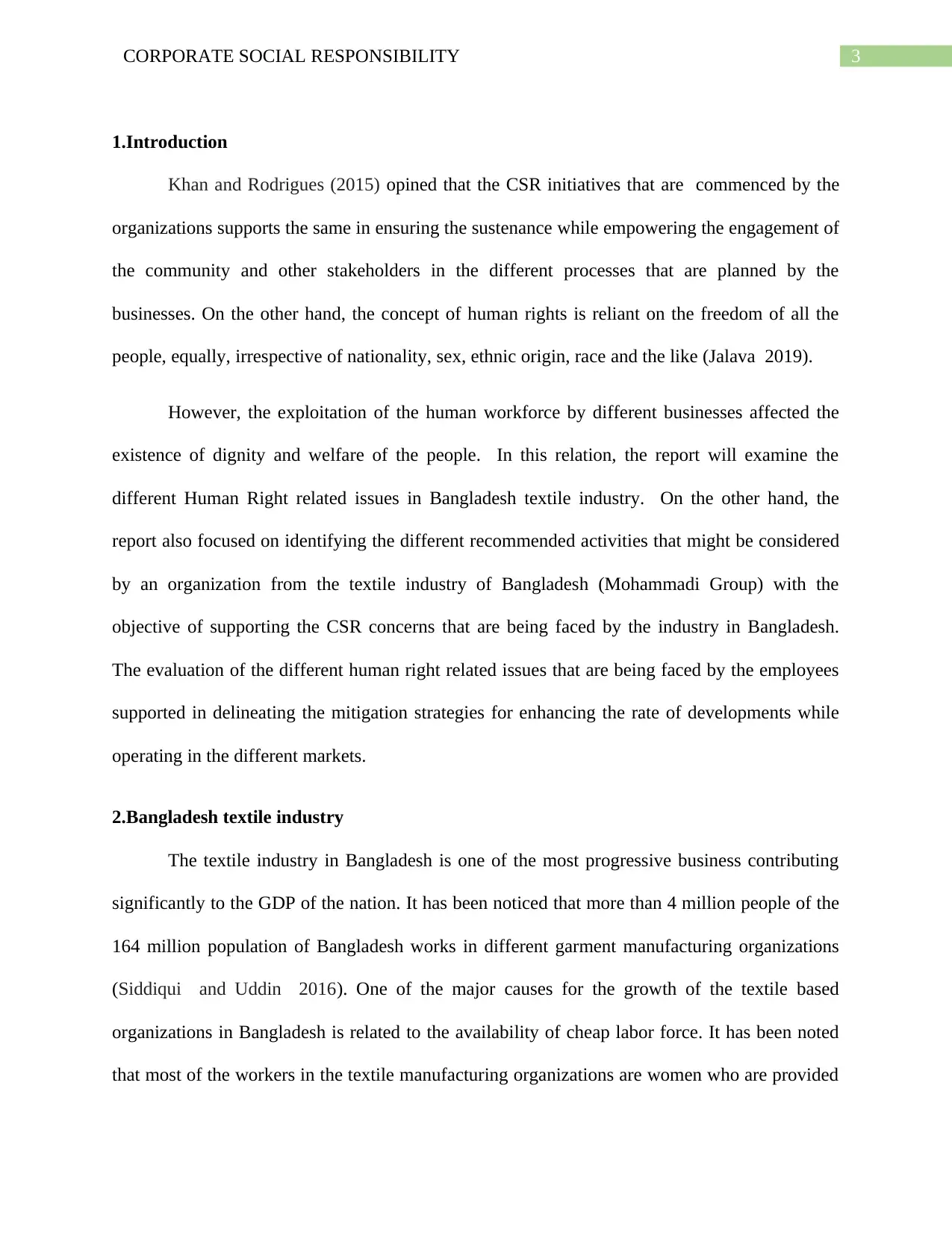
3CORPORATE SOCIAL RESPONSIBILITY
1.Introduction
Khan and Rodrigues (2015) opined that the CSR initiatives that are commenced by the
organizations supports the same in ensuring the sustenance while empowering the engagement of
the community and other stakeholders in the different processes that are planned by the
businesses. On the other hand, the concept of human rights is reliant on the freedom of all the
people, equally, irrespective of nationality, sex, ethnic origin, race and the like (Jalava 2019).
However, the exploitation of the human workforce by different businesses affected the
existence of dignity and welfare of the people. In this relation, the report will examine the
different Human Right related issues in Bangladesh textile industry. On the other hand, the
report also focused on identifying the different recommended activities that might be considered
by an organization from the textile industry of Bangladesh (Mohammadi Group) with the
objective of supporting the CSR concerns that are being faced by the industry in Bangladesh.
The evaluation of the different human right related issues that are being faced by the employees
supported in delineating the mitigation strategies for enhancing the rate of developments while
operating in the different markets.
2.Bangladesh textile industry
The textile industry in Bangladesh is one of the most progressive business contributing
significantly to the GDP of the nation. It has been noticed that more than 4 million people of the
164 million population of Bangladesh works in different garment manufacturing organizations
(Siddiqui and Uddin 2016). One of the major causes for the growth of the textile based
organizations in Bangladesh is related to the availability of cheap labor force. It has been noted
that most of the workers in the textile manufacturing organizations are women who are provided
1.Introduction
Khan and Rodrigues (2015) opined that the CSR initiatives that are commenced by the
organizations supports the same in ensuring the sustenance while empowering the engagement of
the community and other stakeholders in the different processes that are planned by the
businesses. On the other hand, the concept of human rights is reliant on the freedom of all the
people, equally, irrespective of nationality, sex, ethnic origin, race and the like (Jalava 2019).
However, the exploitation of the human workforce by different businesses affected the
existence of dignity and welfare of the people. In this relation, the report will examine the
different Human Right related issues in Bangladesh textile industry. On the other hand, the
report also focused on identifying the different recommended activities that might be considered
by an organization from the textile industry of Bangladesh (Mohammadi Group) with the
objective of supporting the CSR concerns that are being faced by the industry in Bangladesh.
The evaluation of the different human right related issues that are being faced by the employees
supported in delineating the mitigation strategies for enhancing the rate of developments while
operating in the different markets.
2.Bangladesh textile industry
The textile industry in Bangladesh is one of the most progressive business contributing
significantly to the GDP of the nation. It has been noticed that more than 4 million people of the
164 million population of Bangladesh works in different garment manufacturing organizations
(Siddiqui and Uddin 2016). One of the major causes for the growth of the textile based
organizations in Bangladesh is related to the availability of cheap labor force. It has been noted
that most of the workers in the textile manufacturing organizations are women who are provided
Paraphrase This Document
Need a fresh take? Get an instant paraphrase of this document with our AI Paraphraser
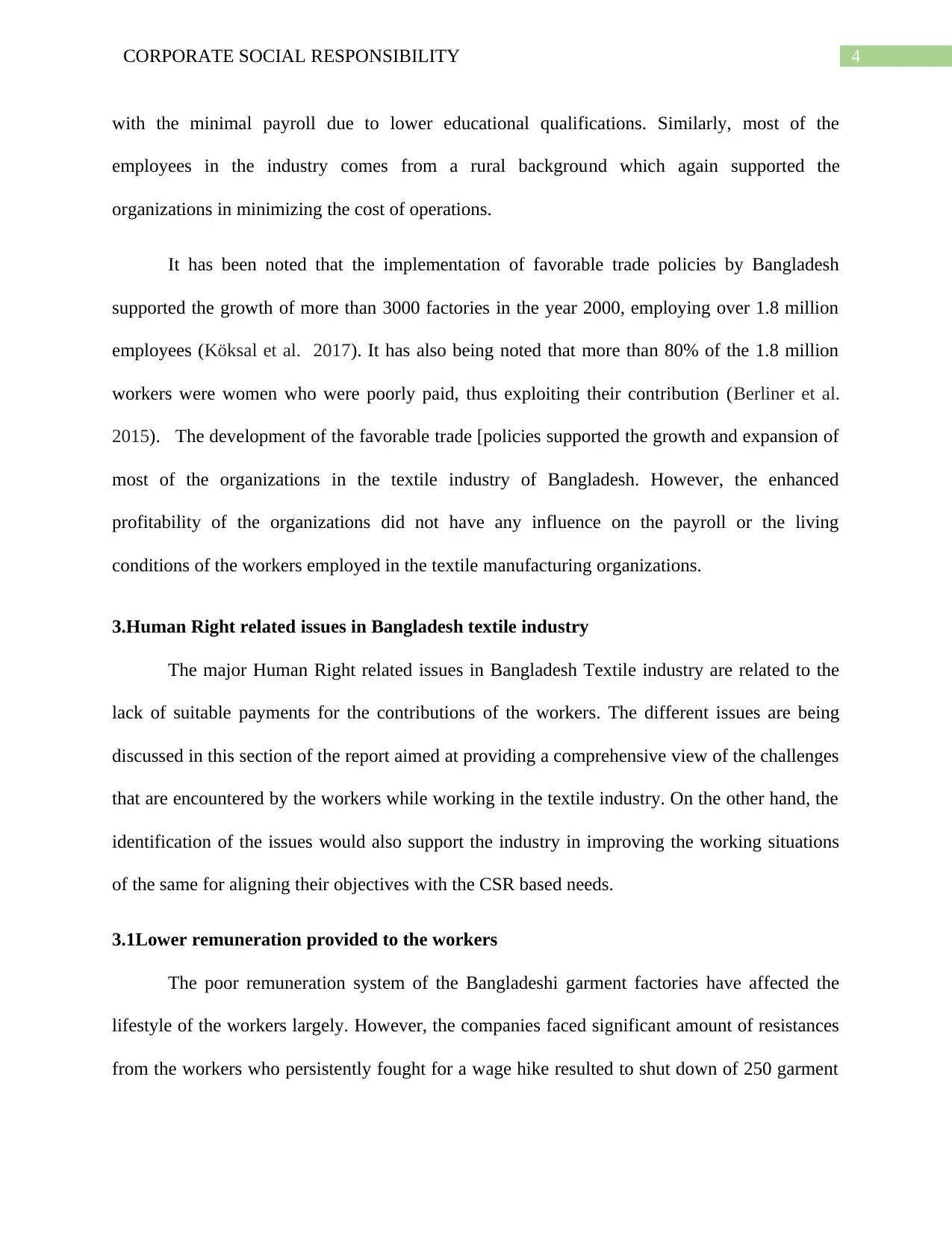
4CORPORATE SOCIAL RESPONSIBILITY
with the minimal payroll due to lower educational qualifications. Similarly, most of the
employees in the industry comes from a rural background which again supported the
organizations in minimizing the cost of operations.
It has been noted that the implementation of favorable trade policies by Bangladesh
supported the growth of more than 3000 factories in the year 2000, employing over 1.8 million
employees (Köksal et al. 2017). It has also being noted that more than 80% of the 1.8 million
workers were women who were poorly paid, thus exploiting their contribution (Berliner et al.
2015). The development of the favorable trade [policies supported the growth and expansion of
most of the organizations in the textile industry of Bangladesh. However, the enhanced
profitability of the organizations did not have any influence on the payroll or the living
conditions of the workers employed in the textile manufacturing organizations.
3.Human Right related issues in Bangladesh textile industry
The major Human Right related issues in Bangladesh Textile industry are related to the
lack of suitable payments for the contributions of the workers. The different issues are being
discussed in this section of the report aimed at providing a comprehensive view of the challenges
that are encountered by the workers while working in the textile industry. On the other hand, the
identification of the issues would also support the industry in improving the working situations
of the same for aligning their objectives with the CSR based needs.
3.1Lower remuneration provided to the workers
The poor remuneration system of the Bangladeshi garment factories have affected the
lifestyle of the workers largely. However, the companies faced significant amount of resistances
from the workers who persistently fought for a wage hike resulted to shut down of 250 garment
with the minimal payroll due to lower educational qualifications. Similarly, most of the
employees in the industry comes from a rural background which again supported the
organizations in minimizing the cost of operations.
It has been noted that the implementation of favorable trade policies by Bangladesh
supported the growth of more than 3000 factories in the year 2000, employing over 1.8 million
employees (Köksal et al. 2017). It has also being noted that more than 80% of the 1.8 million
workers were women who were poorly paid, thus exploiting their contribution (Berliner et al.
2015). The development of the favorable trade [policies supported the growth and expansion of
most of the organizations in the textile industry of Bangladesh. However, the enhanced
profitability of the organizations did not have any influence on the payroll or the living
conditions of the workers employed in the textile manufacturing organizations.
3.Human Right related issues in Bangladesh textile industry
The major Human Right related issues in Bangladesh Textile industry are related to the
lack of suitable payments for the contributions of the workers. The different issues are being
discussed in this section of the report aimed at providing a comprehensive view of the challenges
that are encountered by the workers while working in the textile industry. On the other hand, the
identification of the issues would also support the industry in improving the working situations
of the same for aligning their objectives with the CSR based needs.
3.1Lower remuneration provided to the workers
The poor remuneration system of the Bangladeshi garment factories have affected the
lifestyle of the workers largely. However, the companies faced significant amount of resistances
from the workers who persistently fought for a wage hike resulted to shut down of 250 garment
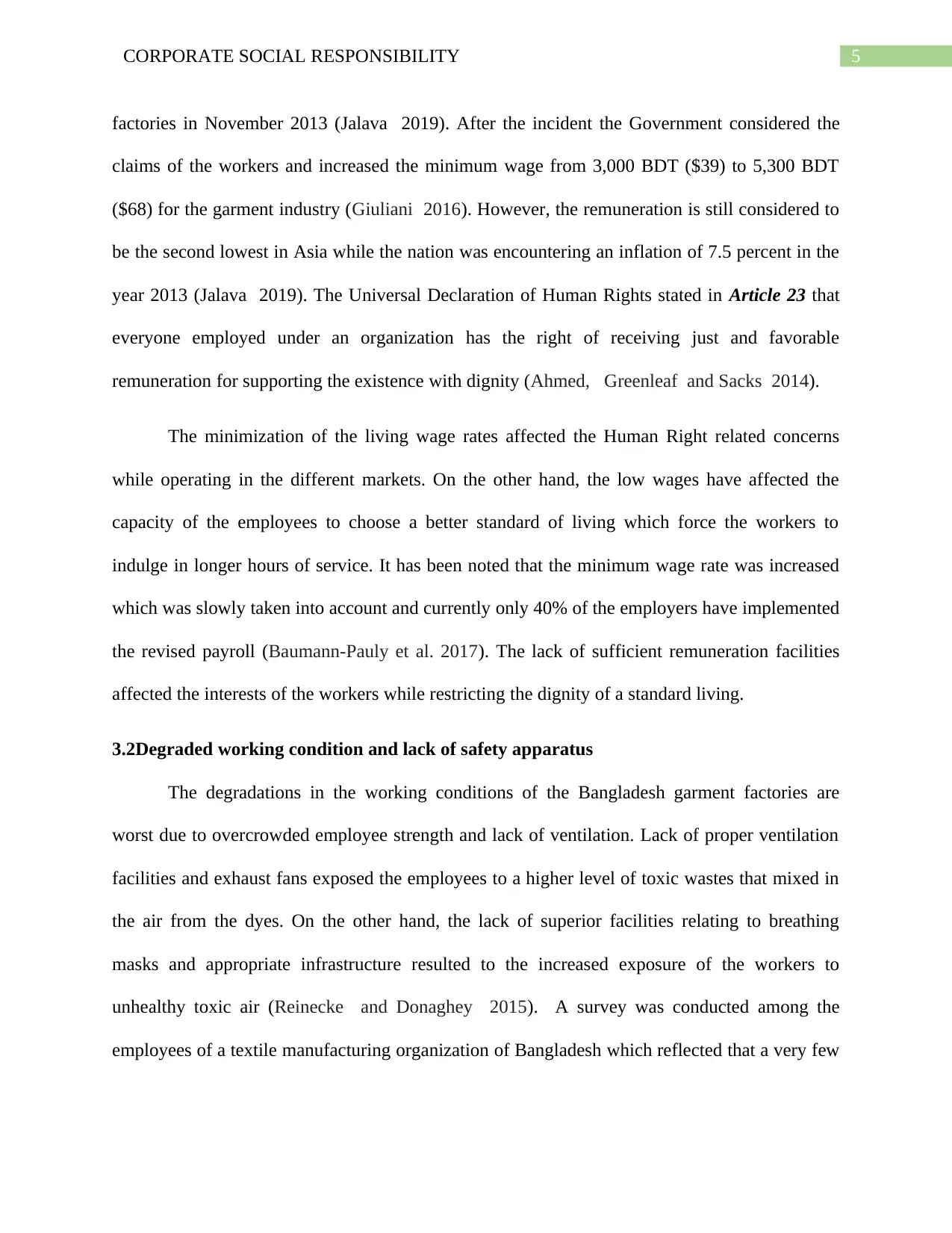
5CORPORATE SOCIAL RESPONSIBILITY
factories in November 2013 (Jalava 2019). After the incident the Government considered the
claims of the workers and increased the minimum wage from 3,000 BDT ($39) to 5,300 BDT
($68) for the garment industry (Giuliani 2016). However, the remuneration is still considered to
be the second lowest in Asia while the nation was encountering an inflation of 7.5 percent in the
year 2013 (Jalava 2019). The Universal Declaration of Human Rights stated in Article 23 that
everyone employed under an organization has the right of receiving just and favorable
remuneration for supporting the existence with dignity (Ahmed, Greenleaf and Sacks 2014).
The minimization of the living wage rates affected the Human Right related concerns
while operating in the different markets. On the other hand, the low wages have affected the
capacity of the employees to choose a better standard of living which force the workers to
indulge in longer hours of service. It has been noted that the minimum wage rate was increased
which was slowly taken into account and currently only 40% of the employers have implemented
the revised payroll (Baumann-Pauly et al. 2017). The lack of sufficient remuneration facilities
affected the interests of the workers while restricting the dignity of a standard living.
3.2Degraded working condition and lack of safety apparatus
The degradations in the working conditions of the Bangladesh garment factories are
worst due to overcrowded employee strength and lack of ventilation. Lack of proper ventilation
facilities and exhaust fans exposed the employees to a higher level of toxic wastes that mixed in
the air from the dyes. On the other hand, the lack of superior facilities relating to breathing
masks and appropriate infrastructure resulted to the increased exposure of the workers to
unhealthy toxic air (Reinecke and Donaghey 2015). A survey was conducted among the
employees of a textile manufacturing organization of Bangladesh which reflected that a very few
factories in November 2013 (Jalava 2019). After the incident the Government considered the
claims of the workers and increased the minimum wage from 3,000 BDT ($39) to 5,300 BDT
($68) for the garment industry (Giuliani 2016). However, the remuneration is still considered to
be the second lowest in Asia while the nation was encountering an inflation of 7.5 percent in the
year 2013 (Jalava 2019). The Universal Declaration of Human Rights stated in Article 23 that
everyone employed under an organization has the right of receiving just and favorable
remuneration for supporting the existence with dignity (Ahmed, Greenleaf and Sacks 2014).
The minimization of the living wage rates affected the Human Right related concerns
while operating in the different markets. On the other hand, the low wages have affected the
capacity of the employees to choose a better standard of living which force the workers to
indulge in longer hours of service. It has been noted that the minimum wage rate was increased
which was slowly taken into account and currently only 40% of the employers have implemented
the revised payroll (Baumann-Pauly et al. 2017). The lack of sufficient remuneration facilities
affected the interests of the workers while restricting the dignity of a standard living.
3.2Degraded working condition and lack of safety apparatus
The degradations in the working conditions of the Bangladesh garment factories are
worst due to overcrowded employee strength and lack of ventilation. Lack of proper ventilation
facilities and exhaust fans exposed the employees to a higher level of toxic wastes that mixed in
the air from the dyes. On the other hand, the lack of superior facilities relating to breathing
masks and appropriate infrastructure resulted to the increased exposure of the workers to
unhealthy toxic air (Reinecke and Donaghey 2015). A survey was conducted among the
employees of a textile manufacturing organization of Bangladesh which reflected that a very few
⊘ This is a preview!⊘
Do you want full access?
Subscribe today to unlock all pages.

Trusted by 1+ million students worldwide
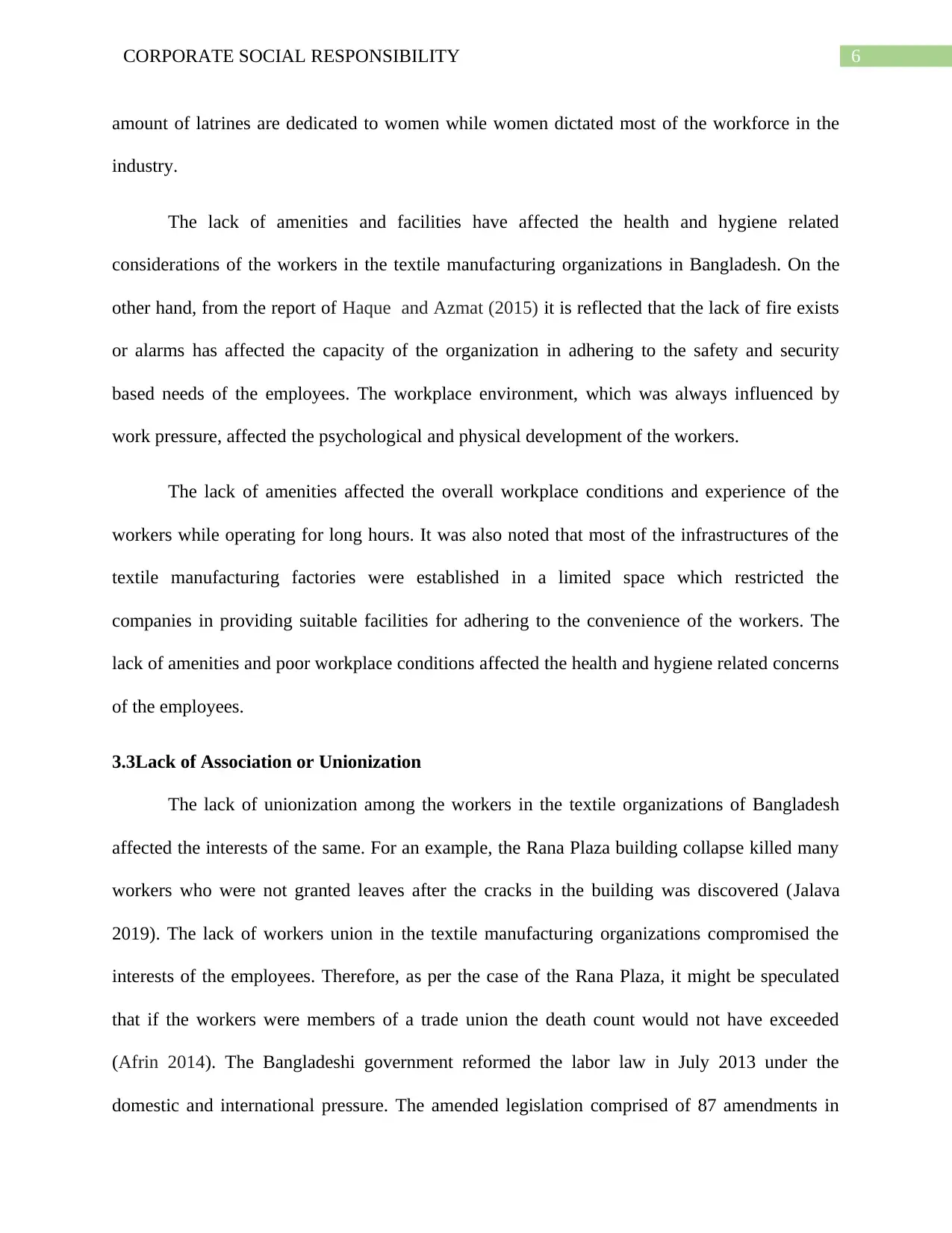
6CORPORATE SOCIAL RESPONSIBILITY
amount of latrines are dedicated to women while women dictated most of the workforce in the
industry.
The lack of amenities and facilities have affected the health and hygiene related
considerations of the workers in the textile manufacturing organizations in Bangladesh. On the
other hand, from the report of Haque and Azmat (2015) it is reflected that the lack of fire exists
or alarms has affected the capacity of the organization in adhering to the safety and security
based needs of the employees. The workplace environment, which was always influenced by
work pressure, affected the psychological and physical development of the workers.
The lack of amenities affected the overall workplace conditions and experience of the
workers while operating for long hours. It was also noted that most of the infrastructures of the
textile manufacturing factories were established in a limited space which restricted the
companies in providing suitable facilities for adhering to the convenience of the workers. The
lack of amenities and poor workplace conditions affected the health and hygiene related concerns
of the employees.
3.3Lack of Association or Unionization
The lack of unionization among the workers in the textile organizations of Bangladesh
affected the interests of the same. For an example, the Rana Plaza building collapse killed many
workers who were not granted leaves after the cracks in the building was discovered (Jalava
2019). The lack of workers union in the textile manufacturing organizations compromised the
interests of the employees. Therefore, as per the case of the Rana Plaza, it might be speculated
that if the workers were members of a trade union the death count would not have exceeded
(Afrin 2014). The Bangladeshi government reformed the labor law in July 2013 under the
domestic and international pressure. The amended legislation comprised of 87 amendments in
amount of latrines are dedicated to women while women dictated most of the workforce in the
industry.
The lack of amenities and facilities have affected the health and hygiene related
considerations of the workers in the textile manufacturing organizations in Bangladesh. On the
other hand, from the report of Haque and Azmat (2015) it is reflected that the lack of fire exists
or alarms has affected the capacity of the organization in adhering to the safety and security
based needs of the employees. The workplace environment, which was always influenced by
work pressure, affected the psychological and physical development of the workers.
The lack of amenities affected the overall workplace conditions and experience of the
workers while operating for long hours. It was also noted that most of the infrastructures of the
textile manufacturing factories were established in a limited space which restricted the
companies in providing suitable facilities for adhering to the convenience of the workers. The
lack of amenities and poor workplace conditions affected the health and hygiene related concerns
of the employees.
3.3Lack of Association or Unionization
The lack of unionization among the workers in the textile organizations of Bangladesh
affected the interests of the same. For an example, the Rana Plaza building collapse killed many
workers who were not granted leaves after the cracks in the building was discovered (Jalava
2019). The lack of workers union in the textile manufacturing organizations compromised the
interests of the employees. Therefore, as per the case of the Rana Plaza, it might be speculated
that if the workers were members of a trade union the death count would not have exceeded
(Afrin 2014). The Bangladeshi government reformed the labor law in July 2013 under the
domestic and international pressure. The amended legislation comprised of 87 amendments in
Paraphrase This Document
Need a fresh take? Get an instant paraphrase of this document with our AI Paraphraser
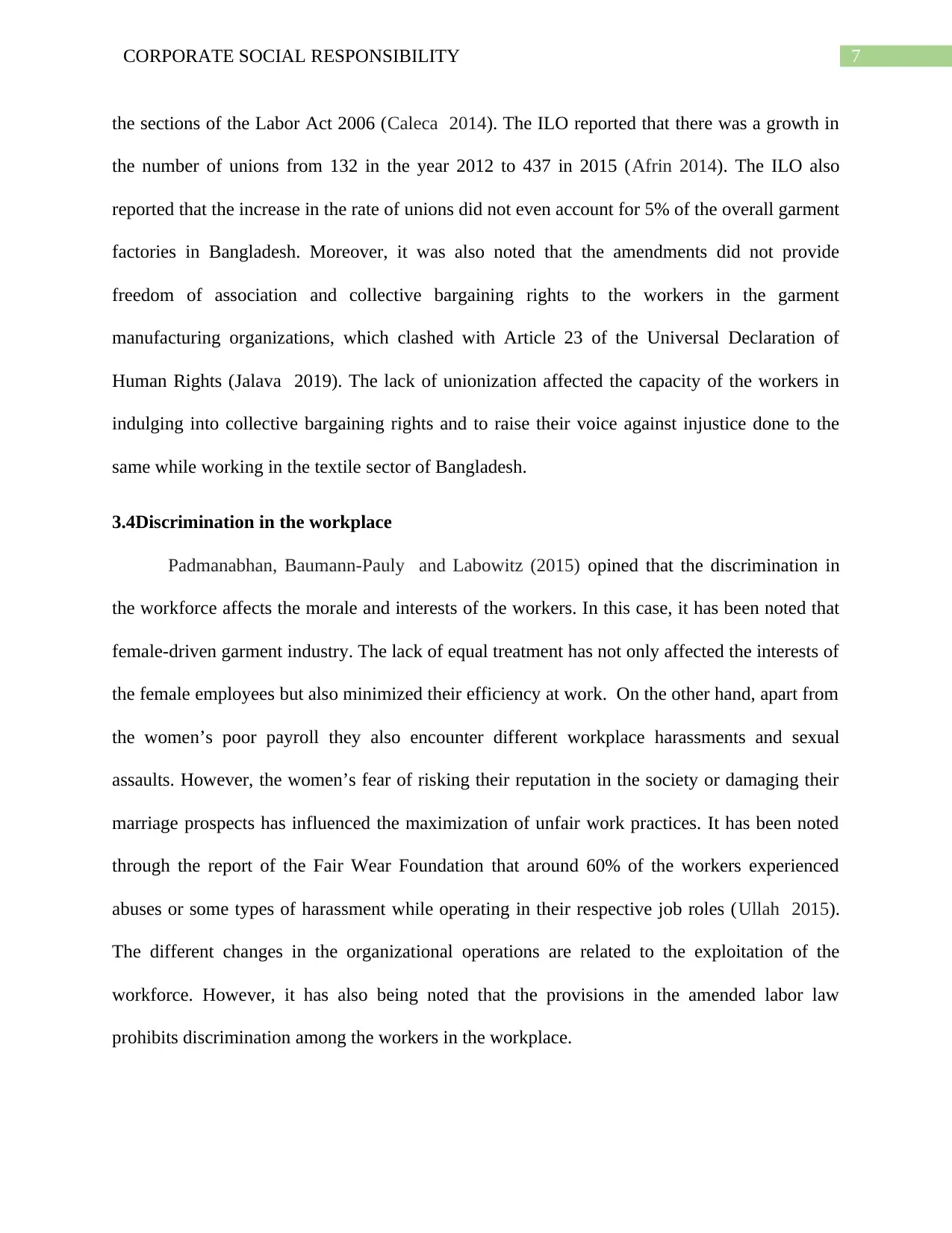
7CORPORATE SOCIAL RESPONSIBILITY
the sections of the Labor Act 2006 (Caleca 2014). The ILO reported that there was a growth in
the number of unions from 132 in the year 2012 to 437 in 2015 (Afrin 2014). The ILO also
reported that the increase in the rate of unions did not even account for 5% of the overall garment
factories in Bangladesh. Moreover, it was also noted that the amendments did not provide
freedom of association and collective bargaining rights to the workers in the garment
manufacturing organizations, which clashed with Article 23 of the Universal Declaration of
Human Rights (Jalava 2019). The lack of unionization affected the capacity of the workers in
indulging into collective bargaining rights and to raise their voice against injustice done to the
same while working in the textile sector of Bangladesh.
3.4Discrimination in the workplace
Padmanabhan, Baumann-Pauly and Labowitz (2015) opined that the discrimination in
the workforce affects the morale and interests of the workers. In this case, it has been noted that
female-driven garment industry. The lack of equal treatment has not only affected the interests of
the female employees but also minimized their efficiency at work. On the other hand, apart from
the women’s poor payroll they also encounter different workplace harassments and sexual
assaults. However, the women’s fear of risking their reputation in the society or damaging their
marriage prospects has influenced the maximization of unfair work practices. It has been noted
through the report of the Fair Wear Foundation that around 60% of the workers experienced
abuses or some types of harassment while operating in their respective job roles (Ullah 2015).
The different changes in the organizational operations are related to the exploitation of the
workforce. However, it has also being noted that the provisions in the amended labor law
prohibits discrimination among the workers in the workplace.
the sections of the Labor Act 2006 (Caleca 2014). The ILO reported that there was a growth in
the number of unions from 132 in the year 2012 to 437 in 2015 (Afrin 2014). The ILO also
reported that the increase in the rate of unions did not even account for 5% of the overall garment
factories in Bangladesh. Moreover, it was also noted that the amendments did not provide
freedom of association and collective bargaining rights to the workers in the garment
manufacturing organizations, which clashed with Article 23 of the Universal Declaration of
Human Rights (Jalava 2019). The lack of unionization affected the capacity of the workers in
indulging into collective bargaining rights and to raise their voice against injustice done to the
same while working in the textile sector of Bangladesh.
3.4Discrimination in the workplace
Padmanabhan, Baumann-Pauly and Labowitz (2015) opined that the discrimination in
the workforce affects the morale and interests of the workers. In this case, it has been noted that
female-driven garment industry. The lack of equal treatment has not only affected the interests of
the female employees but also minimized their efficiency at work. On the other hand, apart from
the women’s poor payroll they also encounter different workplace harassments and sexual
assaults. However, the women’s fear of risking their reputation in the society or damaging their
marriage prospects has influenced the maximization of unfair work practices. It has been noted
through the report of the Fair Wear Foundation that around 60% of the workers experienced
abuses or some types of harassment while operating in their respective job roles (Ullah 2015).
The different changes in the organizational operations are related to the exploitation of the
workforce. However, it has also being noted that the provisions in the amended labor law
prohibits discrimination among the workers in the workplace.
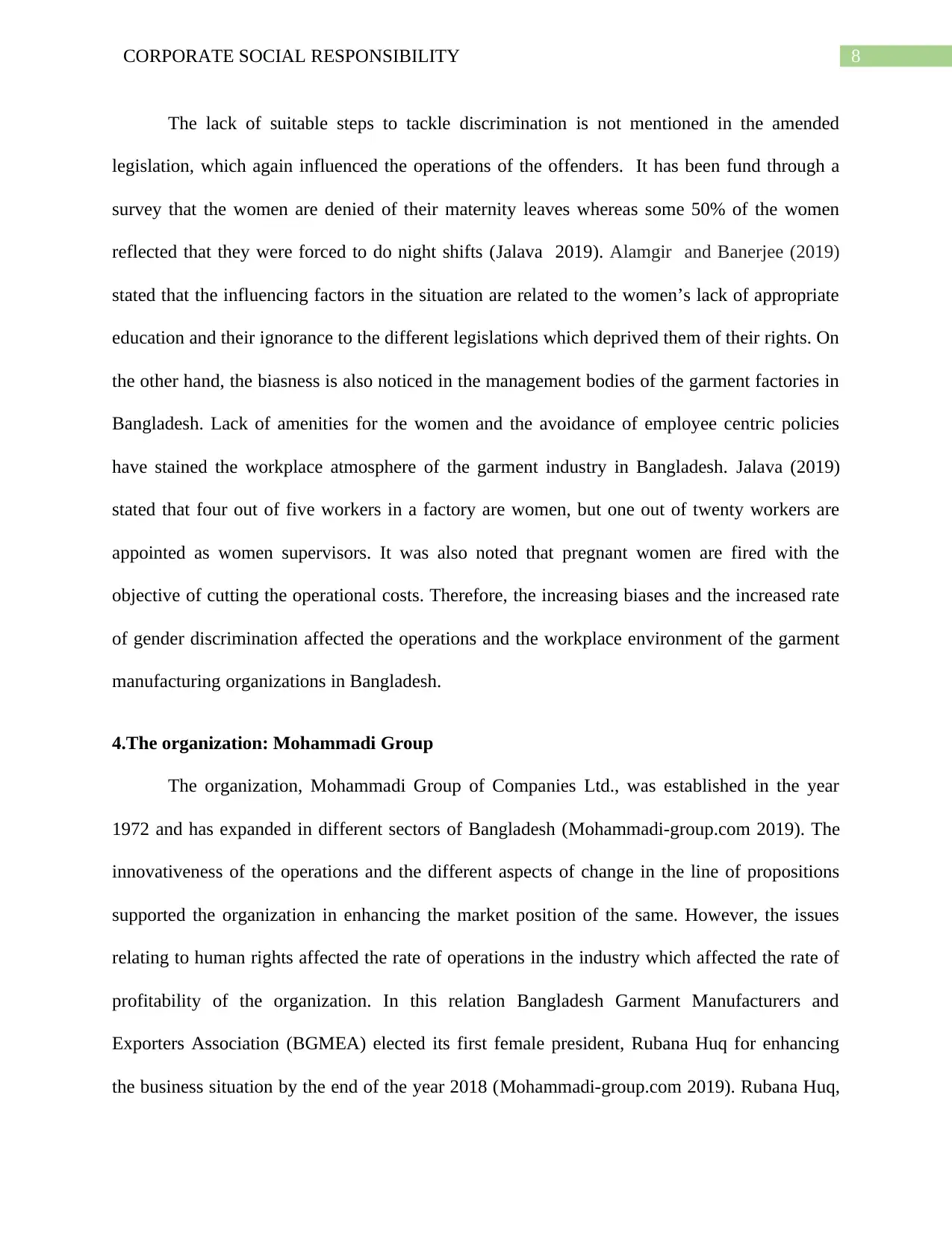
8CORPORATE SOCIAL RESPONSIBILITY
The lack of suitable steps to tackle discrimination is not mentioned in the amended
legislation, which again influenced the operations of the offenders. It has been fund through a
survey that the women are denied of their maternity leaves whereas some 50% of the women
reflected that they were forced to do night shifts (Jalava 2019). Alamgir and Banerjee (2019)
stated that the influencing factors in the situation are related to the women’s lack of appropriate
education and their ignorance to the different legislations which deprived them of their rights. On
the other hand, the biasness is also noticed in the management bodies of the garment factories in
Bangladesh. Lack of amenities for the women and the avoidance of employee centric policies
have stained the workplace atmosphere of the garment industry in Bangladesh. Jalava (2019)
stated that four out of five workers in a factory are women, but one out of twenty workers are
appointed as women supervisors. It was also noted that pregnant women are fired with the
objective of cutting the operational costs. Therefore, the increasing biases and the increased rate
of gender discrimination affected the operations and the workplace environment of the garment
manufacturing organizations in Bangladesh.
4.The organization: Mohammadi Group
The organization, Mohammadi Group of Companies Ltd., was established in the year
1972 and has expanded in different sectors of Bangladesh (Mohammadi-group.com 2019). The
innovativeness of the operations and the different aspects of change in the line of propositions
supported the organization in enhancing the market position of the same. However, the issues
relating to human rights affected the rate of operations in the industry which affected the rate of
profitability of the organization. In this relation Bangladesh Garment Manufacturers and
Exporters Association (BGMEA) elected its first female president, Rubana Huq for enhancing
the business situation by the end of the year 2018 (Mohammadi-group.com 2019). Rubana Huq,
The lack of suitable steps to tackle discrimination is not mentioned in the amended
legislation, which again influenced the operations of the offenders. It has been fund through a
survey that the women are denied of their maternity leaves whereas some 50% of the women
reflected that they were forced to do night shifts (Jalava 2019). Alamgir and Banerjee (2019)
stated that the influencing factors in the situation are related to the women’s lack of appropriate
education and their ignorance to the different legislations which deprived them of their rights. On
the other hand, the biasness is also noticed in the management bodies of the garment factories in
Bangladesh. Lack of amenities for the women and the avoidance of employee centric policies
have stained the workplace atmosphere of the garment industry in Bangladesh. Jalava (2019)
stated that four out of five workers in a factory are women, but one out of twenty workers are
appointed as women supervisors. It was also noted that pregnant women are fired with the
objective of cutting the operational costs. Therefore, the increasing biases and the increased rate
of gender discrimination affected the operations and the workplace environment of the garment
manufacturing organizations in Bangladesh.
4.The organization: Mohammadi Group
The organization, Mohammadi Group of Companies Ltd., was established in the year
1972 and has expanded in different sectors of Bangladesh (Mohammadi-group.com 2019). The
innovativeness of the operations and the different aspects of change in the line of propositions
supported the organization in enhancing the market position of the same. However, the issues
relating to human rights affected the rate of operations in the industry which affected the rate of
profitability of the organization. In this relation Bangladesh Garment Manufacturers and
Exporters Association (BGMEA) elected its first female president, Rubana Huq for enhancing
the business situation by the end of the year 2018 (Mohammadi-group.com 2019). Rubana Huq,
⊘ This is a preview!⊘
Do you want full access?
Subscribe today to unlock all pages.

Trusted by 1+ million students worldwide
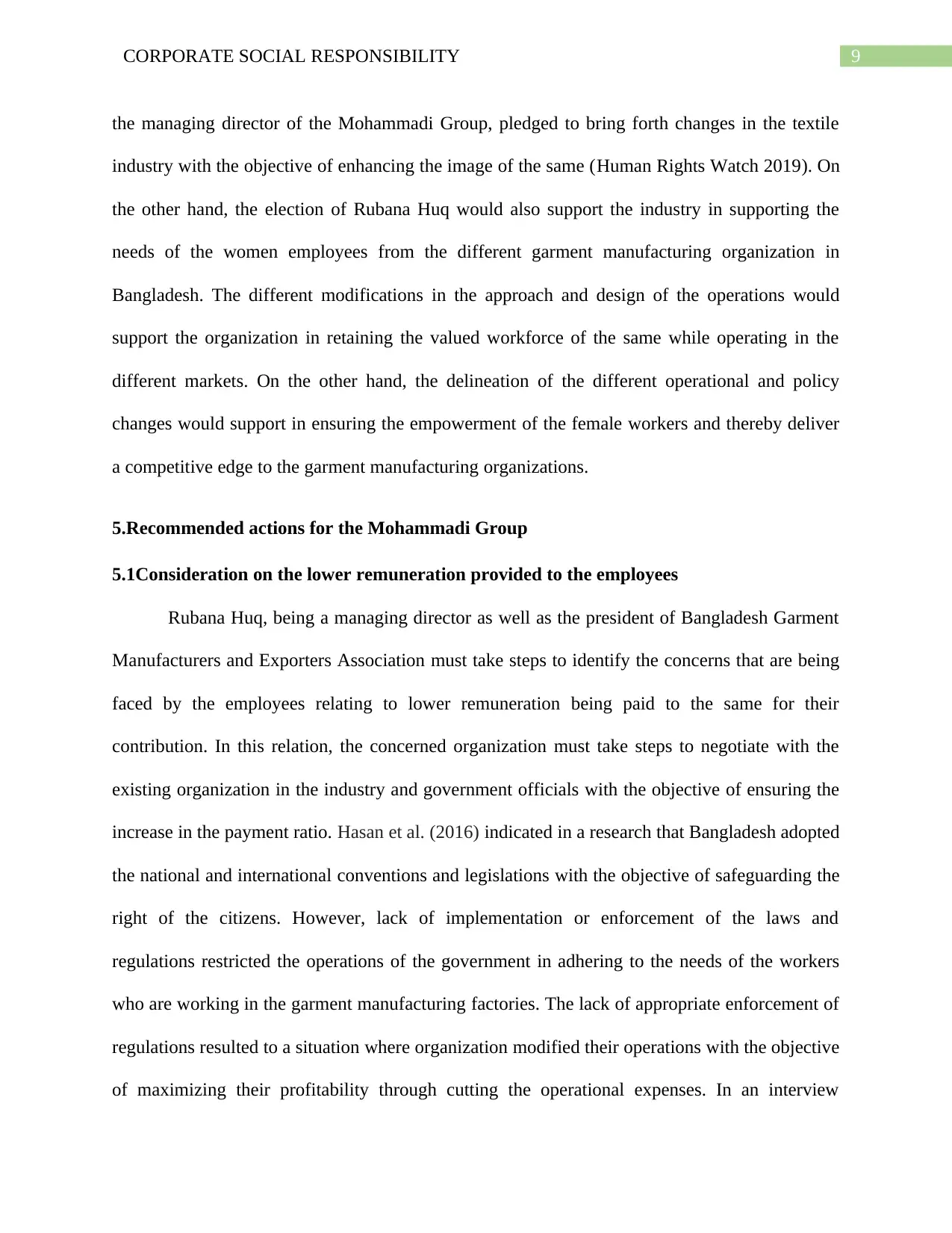
9CORPORATE SOCIAL RESPONSIBILITY
the managing director of the Mohammadi Group, pledged to bring forth changes in the textile
industry with the objective of enhancing the image of the same (Human Rights Watch 2019). On
the other hand, the election of Rubana Huq would also support the industry in supporting the
needs of the women employees from the different garment manufacturing organization in
Bangladesh. The different modifications in the approach and design of the operations would
support the organization in retaining the valued workforce of the same while operating in the
different markets. On the other hand, the delineation of the different operational and policy
changes would support in ensuring the empowerment of the female workers and thereby deliver
a competitive edge to the garment manufacturing organizations.
5.Recommended actions for the Mohammadi Group
5.1Consideration on the lower remuneration provided to the employees
Rubana Huq, being a managing director as well as the president of Bangladesh Garment
Manufacturers and Exporters Association must take steps to identify the concerns that are being
faced by the employees relating to lower remuneration being paid to the same for their
contribution. In this relation, the concerned organization must take steps to negotiate with the
existing organization in the industry and government officials with the objective of ensuring the
increase in the payment ratio. Hasan et al. (2016) indicated in a research that Bangladesh adopted
the national and international conventions and legislations with the objective of safeguarding the
right of the citizens. However, lack of implementation or enforcement of the laws and
regulations restricted the operations of the government in adhering to the needs of the workers
who are working in the garment manufacturing factories. The lack of appropriate enforcement of
regulations resulted to a situation where organization modified their operations with the objective
of maximizing their profitability through cutting the operational expenses. In an interview
the managing director of the Mohammadi Group, pledged to bring forth changes in the textile
industry with the objective of enhancing the image of the same (Human Rights Watch 2019). On
the other hand, the election of Rubana Huq would also support the industry in supporting the
needs of the women employees from the different garment manufacturing organization in
Bangladesh. The different modifications in the approach and design of the operations would
support the organization in retaining the valued workforce of the same while operating in the
different markets. On the other hand, the delineation of the different operational and policy
changes would support in ensuring the empowerment of the female workers and thereby deliver
a competitive edge to the garment manufacturing organizations.
5.Recommended actions for the Mohammadi Group
5.1Consideration on the lower remuneration provided to the employees
Rubana Huq, being a managing director as well as the president of Bangladesh Garment
Manufacturers and Exporters Association must take steps to identify the concerns that are being
faced by the employees relating to lower remuneration being paid to the same for their
contribution. In this relation, the concerned organization must take steps to negotiate with the
existing organization in the industry and government officials with the objective of ensuring the
increase in the payment ratio. Hasan et al. (2016) indicated in a research that Bangladesh adopted
the national and international conventions and legislations with the objective of safeguarding the
right of the citizens. However, lack of implementation or enforcement of the laws and
regulations restricted the operations of the government in adhering to the needs of the workers
who are working in the garment manufacturing factories. The lack of appropriate enforcement of
regulations resulted to a situation where organization modified their operations with the objective
of maximizing their profitability through cutting the operational expenses. In an interview
Paraphrase This Document
Need a fresh take? Get an instant paraphrase of this document with our AI Paraphraser
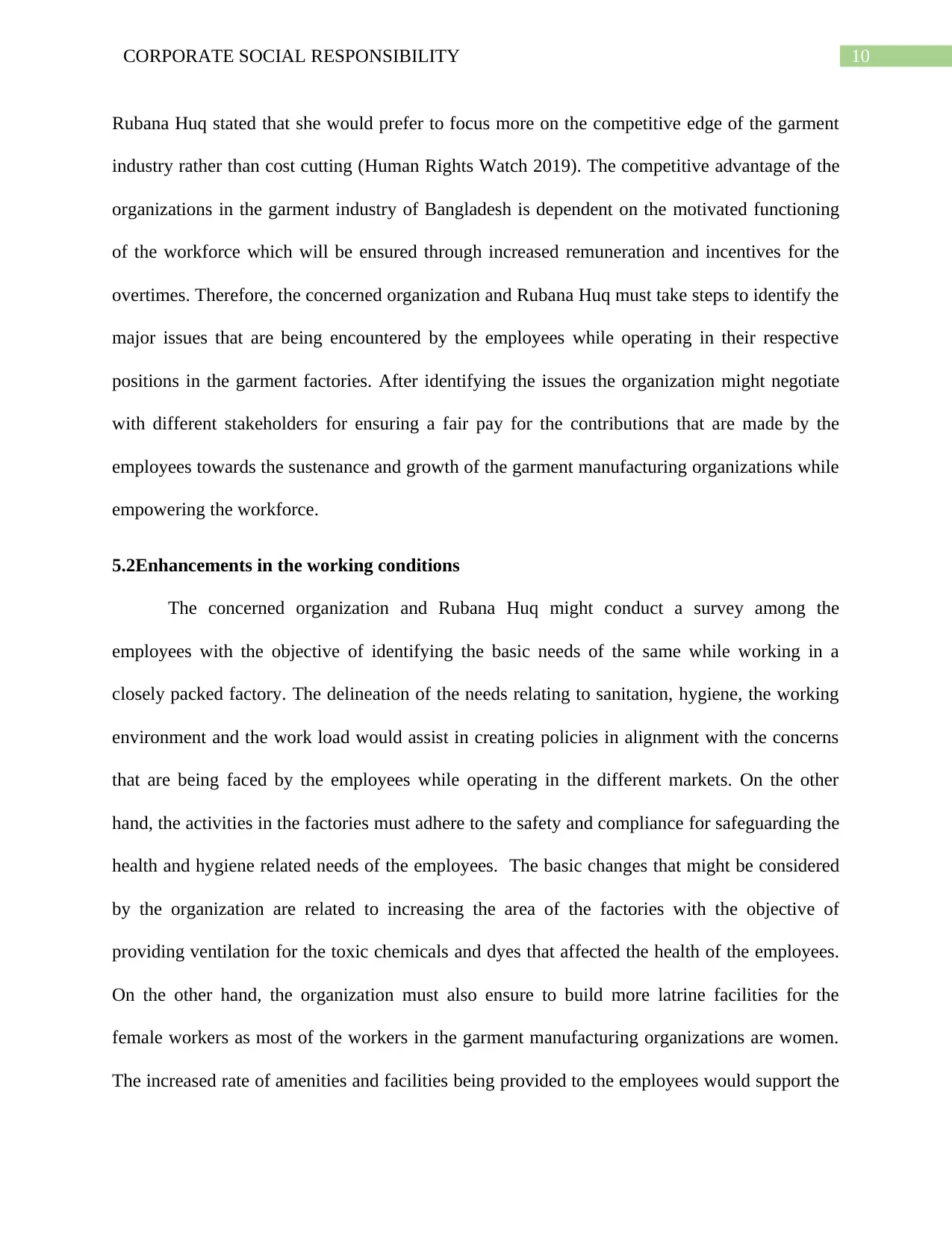
10CORPORATE SOCIAL RESPONSIBILITY
Rubana Huq stated that she would prefer to focus more on the competitive edge of the garment
industry rather than cost cutting (Human Rights Watch 2019). The competitive advantage of the
organizations in the garment industry of Bangladesh is dependent on the motivated functioning
of the workforce which will be ensured through increased remuneration and incentives for the
overtimes. Therefore, the concerned organization and Rubana Huq must take steps to identify the
major issues that are being encountered by the employees while operating in their respective
positions in the garment factories. After identifying the issues the organization might negotiate
with different stakeholders for ensuring a fair pay for the contributions that are made by the
employees towards the sustenance and growth of the garment manufacturing organizations while
empowering the workforce.
5.2Enhancements in the working conditions
The concerned organization and Rubana Huq might conduct a survey among the
employees with the objective of identifying the basic needs of the same while working in a
closely packed factory. The delineation of the needs relating to sanitation, hygiene, the working
environment and the work load would assist in creating policies in alignment with the concerns
that are being faced by the employees while operating in the different markets. On the other
hand, the activities in the factories must adhere to the safety and compliance for safeguarding the
health and hygiene related needs of the employees. The basic changes that might be considered
by the organization are related to increasing the area of the factories with the objective of
providing ventilation for the toxic chemicals and dyes that affected the health of the employees.
On the other hand, the organization must also ensure to build more latrine facilities for the
female workers as most of the workers in the garment manufacturing organizations are women.
The increased rate of amenities and facilities being provided to the employees would support the
Rubana Huq stated that she would prefer to focus more on the competitive edge of the garment
industry rather than cost cutting (Human Rights Watch 2019). The competitive advantage of the
organizations in the garment industry of Bangladesh is dependent on the motivated functioning
of the workforce which will be ensured through increased remuneration and incentives for the
overtimes. Therefore, the concerned organization and Rubana Huq must take steps to identify the
major issues that are being encountered by the employees while operating in their respective
positions in the garment factories. After identifying the issues the organization might negotiate
with different stakeholders for ensuring a fair pay for the contributions that are made by the
employees towards the sustenance and growth of the garment manufacturing organizations while
empowering the workforce.
5.2Enhancements in the working conditions
The concerned organization and Rubana Huq might conduct a survey among the
employees with the objective of identifying the basic needs of the same while working in a
closely packed factory. The delineation of the needs relating to sanitation, hygiene, the working
environment and the work load would assist in creating policies in alignment with the concerns
that are being faced by the employees while operating in the different markets. On the other
hand, the activities in the factories must adhere to the safety and compliance for safeguarding the
health and hygiene related needs of the employees. The basic changes that might be considered
by the organization are related to increasing the area of the factories with the objective of
providing ventilation for the toxic chemicals and dyes that affected the health of the employees.
On the other hand, the organization must also ensure to build more latrine facilities for the
female workers as most of the workers in the garment manufacturing organizations are women.
The increased rate of amenities and facilities being provided to the employees would support the
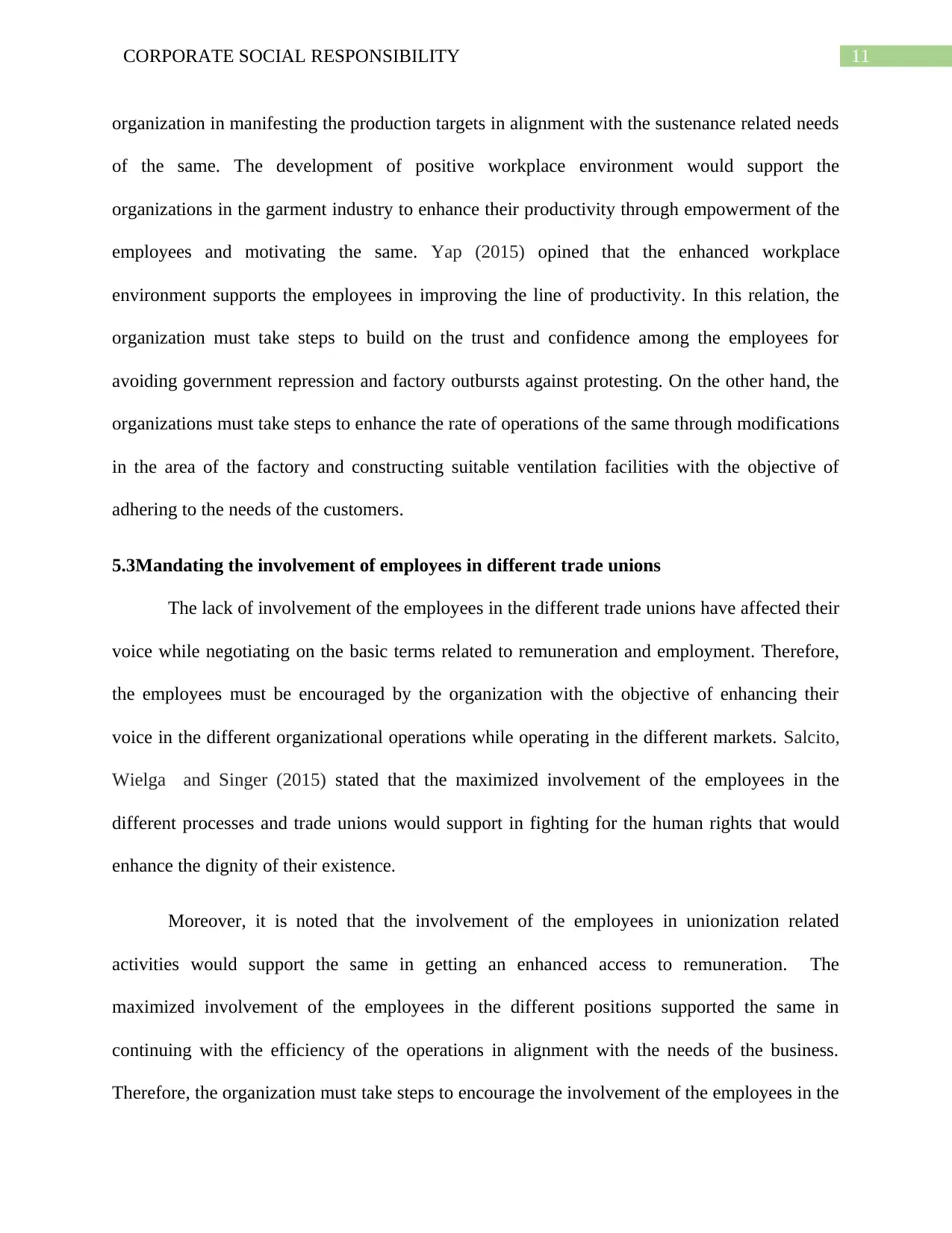
11CORPORATE SOCIAL RESPONSIBILITY
organization in manifesting the production targets in alignment with the sustenance related needs
of the same. The development of positive workplace environment would support the
organizations in the garment industry to enhance their productivity through empowerment of the
employees and motivating the same. Yap (2015) opined that the enhanced workplace
environment supports the employees in improving the line of productivity. In this relation, the
organization must take steps to build on the trust and confidence among the employees for
avoiding government repression and factory outbursts against protesting. On the other hand, the
organizations must take steps to enhance the rate of operations of the same through modifications
in the area of the factory and constructing suitable ventilation facilities with the objective of
adhering to the needs of the customers.
5.3Mandating the involvement of employees in different trade unions
The lack of involvement of the employees in the different trade unions have affected their
voice while negotiating on the basic terms related to remuneration and employment. Therefore,
the employees must be encouraged by the organization with the objective of enhancing their
voice in the different organizational operations while operating in the different markets. Salcito,
Wielga and Singer (2015) stated that the maximized involvement of the employees in the
different processes and trade unions would support in fighting for the human rights that would
enhance the dignity of their existence.
Moreover, it is noted that the involvement of the employees in unionization related
activities would support the same in getting an enhanced access to remuneration. The
maximized involvement of the employees in the different positions supported the same in
continuing with the efficiency of the operations in alignment with the needs of the business.
Therefore, the organization must take steps to encourage the involvement of the employees in the
organization in manifesting the production targets in alignment with the sustenance related needs
of the same. The development of positive workplace environment would support the
organizations in the garment industry to enhance their productivity through empowerment of the
employees and motivating the same. Yap (2015) opined that the enhanced workplace
environment supports the employees in improving the line of productivity. In this relation, the
organization must take steps to build on the trust and confidence among the employees for
avoiding government repression and factory outbursts against protesting. On the other hand, the
organizations must take steps to enhance the rate of operations of the same through modifications
in the area of the factory and constructing suitable ventilation facilities with the objective of
adhering to the needs of the customers.
5.3Mandating the involvement of employees in different trade unions
The lack of involvement of the employees in the different trade unions have affected their
voice while negotiating on the basic terms related to remuneration and employment. Therefore,
the employees must be encouraged by the organization with the objective of enhancing their
voice in the different organizational operations while operating in the different markets. Salcito,
Wielga and Singer (2015) stated that the maximized involvement of the employees in the
different processes and trade unions would support in fighting for the human rights that would
enhance the dignity of their existence.
Moreover, it is noted that the involvement of the employees in unionization related
activities would support the same in getting an enhanced access to remuneration. The
maximized involvement of the employees in the different positions supported the same in
continuing with the efficiency of the operations in alignment with the needs of the business.
Therefore, the organization must take steps to encourage the involvement of the employees in the
⊘ This is a preview!⊘
Do you want full access?
Subscribe today to unlock all pages.

Trusted by 1+ million students worldwide
1 out of 17
Related Documents
Your All-in-One AI-Powered Toolkit for Academic Success.
+13062052269
info@desklib.com
Available 24*7 on WhatsApp / Email
![[object Object]](/_next/static/media/star-bottom.7253800d.svg)
Unlock your academic potential
Copyright © 2020–2025 A2Z Services. All Rights Reserved. Developed and managed by ZUCOL.





